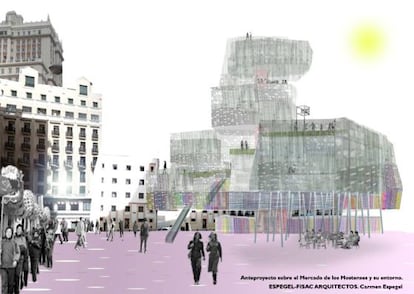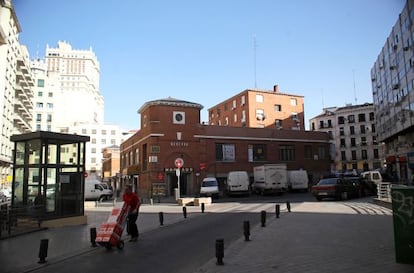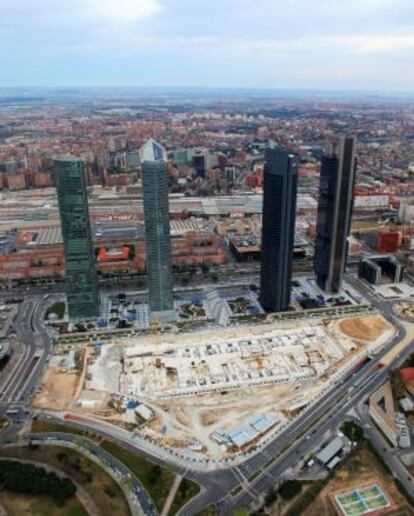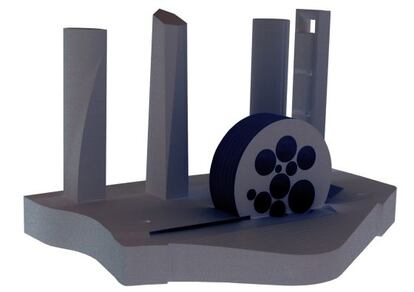The Madrid that may never be
The capital has been transformed by some major building projects in recent years But budget cutbacks have since put the brakes on many other developers' dreams


It's past 6pm, but the security guard who comes out to meet this reporter has beads of sweat rolling down his sideburns.
"There's nobody here but me, building work has been stopped," he says, informatively. "There's nothing to see."
Behind him loom the Cuatro Torres - the four towers. They are behemoths nearly 250 meters tall that watch over the north entrance into Madrid, on the Castellana boulevard. Between them and the security guard's sauna-like cabin, there is a colossal hole in the ground. These 33,000 square meters of empty land are destined to one day hold the International Convention Center - if you look closely, you can dimly guess at its concrete foundations. "Madrid's new architectural icon" is how then-mayor Alberto Ruiz-Gallardón defined it when he laid the first stone in 2008.
This was one of the first projects to be dropped. A year and a half later, the mayor announced he was slashing 600 million euros earmarked for construction out of the city budget. The convention center and the Vallehermoso stadium, among other buildings, would have to wait for better times. In some cases, the crisis was to blame; in others, it was a lack of understanding with government agencies; yet other projects simply fell into oblivion.
The mayor described the Center as "Madrid's new architectural icon"
Over the years, Madrid has successfully completed major works that have transformed the cityscape, albeit at the cost of running up huge debts: bringing the M-30 beltway underground, the regeneration of the Manzanares river area (Madrid Río), the refurbishment of Serrano street, turning Arenal, Ópera, Callao and Fuencarral into pedestrian areas...
But there were other plans that fell along the way. There is a version of Madrid that never was, and perhaps never will be.

"We took the liberty of making important changes in the city. The most radical ones, the ones that transformed its physiognomy, we managed to do right before the crisis," says Beatriz Lobón, general coordinator of the Madrid City Planning Office.
In fact, the city continues to make plans, even if these are now long-term: refurbishing the run-down Plaza de España, opening new connections between the city center and the river... Priority is given to projects that improve the city's image for tourists, says Lobón. Everything else, or in other words, projects that are neither basic nor essential to Madrid's image, will have to wait. "There is no money," repeats Lobón.
We made the most radical changes to the city right before the crisis"
As for the International Convention Center, "it was a very ambitious project," says Emilio Tuñón, one of its architects, speaking in the past tense. Tuñón, together with Matilde Peralta and the recently deceased Luis Mansilla, won the city's competition for ideas in 2007.
"We tried to finish off the area surrounding the Four Towers, which are over 200 meters tall, so we could not work the same way we would in a city center. This called for a bigger scale," he adds. Their spectacular round building would have been 120 meters tall and would have held three auditoriums (one seating up to 6,000), with a parking lot for 5,000 vehicles. It would have cost 300 million euros to build.

Asked if they were disappointed at the fact the project has been put on hold, Tuñón replies that "with this economic situation, perhaps what Madrid needs are other types of facilities, more social ones. Sometimes it is good to stop and take stock. Time is also a building material."
The city does not know how long the convention center project will remain on hold. "Let's see if we can bring the costs down," says Lobón. The political party Unión Progreso y Democracia took city officials to task last June for having already spent 99 million euros on "a hole" that provides no service to Madrileños.
El Coliseo de las Tres Culturas was to be a "living emblem of the 21st century city"
Instead of an enormous pit in the ground, what is left of the grand-sounding Coliseo de las Tres Culturas (the Coliseum of the Three Cultures) is a massive fenced lot with the odd little tree sticking out of the ground in the residential neighborhood of Canillas, in the Hortaleza district. The city reclassified two plots and in 2002 ceded them for 50 years to José Luis Moreno, the theater impresario who is best known to Spaniards as a TV host and ventriloquist. Moreno was planning to build a great art center with three theaters, an art museum, a music conservatory and a school of dramatic arts, among other things.
"A living, charismatic emblem of the 21st century city, making its image identifiable on all five continents," extols the center's website, which is still up.

"It lacked financing and the city got the land back," sums up Lobón. The contract was definitively ended a year ago, although a few unsettled debts were left along the way, and the case is in the hands of the local tax agency.
"This neighborhood needs things like this," said a local pharmacist, standing in front of the lot last Thursday. "I talked to Moreno a few years ago and he was all excited about building the theaters."
All that's left now is a huge fenced lot with the odd tree sticking out of the ground
But the city was never that enthusiastic about it. "Not even the residents agreed to the project," says Lobón. Now the lot awaits Madrid officials to decide its future use.
"A few years ago they called us from Madrid City Hall. They wanted to recover the kiosk, but we told them that the original could not be moved, that they could come study it and make a replica of it," recalls Urbano González, coordinator of the mayor's office at O Porriño. This Galician town was the home of Antonio Palacios, the man who created the Círculo de Bellas Artes, the Palacio de Correos on Cibeles Square and the famous kiosk on Red de San Luis - where Fuencarral street ends and Montera street begins - which housed the elevator for the Gran Vía metro station between 1919 and 1970. The construction, made with granite, iron and glass, was taken apart then, and when O Porriño asked for it back, was sent there stone by stone. These days, part of it (without the marquee) adorns a local park.
Press clippings reveal that there was already talk of rebuilding the kiosk in the late 1990s. In 2008, Alberto Ruiz-Gallardón included a replica in the presentation of his plans to make Fuencarral street off limits to cars.
"Now, a new generation of Madrileños will be able to enjoy a symbol that will have the role of marking the entrance into this pedestrian axis, to which will now be added a new stretch of Fuencarral street," he said.
Instead of a stadium, a private firm is building a sports center on site
"That's all forgotten. The heritage committee does not accept reproductions of old works," says Lobón.
In the back of Gran Vía, there is a square that does not look like one. Los Mostenses market, an uninspired exposed brick building that takes up nearly all the space between Plaza de España and San Bernardo street, needs a facelift. The city has always admitted it. The draft project presented by the architect studio Espegel Fisac included razing the entire construction and replacing it with a glass building containing a library, swimming pool and observation deck, while freeing up most of the square. The cost would have been 30 million euros.
Lobón says this is not even a project per se, and once again it will be money that decides the future of the square. For now, the small business owners who have stalls inside the market are negotiating with the city's department of economic affairs to see if it can at least be reformed on the inside.
The 46-year history of the Vallehermoso stadium was turned to rubble in 2008. The venue was demolished because reconstruction was imminent: the stadium was set to be reborn as a more modern facility with greater seating capacity. But it was knocked out of the budget in 2010. Instead, a private company is now building a sports center on the site with a swimming pool, a gym and padel tennis courts. But there will be no new stadium. "That is no longer an option," admits a source in city government.
I'm more concerned about sidewalks not getting fixed," says one architect
The city planning project that has perhaps generated the most headlines in recent years is the plan to remodel the Prado-Recoletos axis. Ruiz-Gallardón declared part of the thoroughfare a Cultural Interest Site in 1998 in order to have the last word on any reform work. The problem is, he was regional premier of Madrid then. When he was elected mayor, that decision came back to haunt him. The Paseo del Prado, as the Socialist Party recently decried, is in bad shape: the pavement is bumpy, the gardens are looking unkempt, and there is too much road traffic.
Ricardo Aroca, an architect and former dean of the Madrid Architects Association, expands on this issue. "The city can survive without these projects. I am more concerned about a more elemental, simple thing, which is the first sign of decadence in a city: for sidewalks not to get fixed and potholes not filled. And this lack of maintenance is becoming visible," he says.
Aroca believes there was a bubble in this sector as well. "Without this inflation of easy money, certain projects would never have been undertaken. There is hypertrophy."
Tuñón has a similar opinion. "There was a time when things were built too fast. Now things are done with a lot more restraint and rationality," he says.
The project by Álvaro Siza dates back to 2002, and it is 60-percent completed - everything save the Cultural Interest Site area, which is the museum area where thousands of tourists are to be found at all times. The government of regional premier Esperanza Aguirre was supposed to have written up an environmental impact report in April of last year. But the deadline has come and gone, and silence is equivalent to a denial. But city officials are still waiting.
"The administration has the obligation to reply, and we will not relent," says Lobón, while admitting that there is no hurry to start work on this project, either, because, of course, "there is no money."
Tu suscripción se está usando en otro dispositivo
¿Quieres añadir otro usuario a tu suscripción?
Si continúas leyendo en este dispositivo, no se podrá leer en el otro.
FlechaTu suscripción se está usando en otro dispositivo y solo puedes acceder a EL PAÍS desde un dispositivo a la vez.
Si quieres compartir tu cuenta, cambia tu suscripción a la modalidad Premium, así podrás añadir otro usuario. Cada uno accederá con su propia cuenta de email, lo que os permitirá personalizar vuestra experiencia en EL PAÍS.
¿Tienes una suscripción de empresa? Accede aquí para contratar más cuentas.
En el caso de no saber quién está usando tu cuenta, te recomendamos cambiar tu contraseña aquí.
Si decides continuar compartiendo tu cuenta, este mensaje se mostrará en tu dispositivo y en el de la otra persona que está usando tu cuenta de forma indefinida, afectando a tu experiencia de lectura. Puedes consultar aquí los términos y condiciones de la suscripción digital.
Últimas noticias
Mexico seeks to shore up its defenses following US incursion in Venezuela
Hope gives way to uncertainty among Venezuelan exiles in the US after Maduro’s capture
Cubans look to Venezuela fearfully after Trump’s incursion: ‘We could be next’
The operation in Venezuela to capture Maduro threatens to widen the cracks in the MAGA movement
Most viewed
- Alain Aspect, Nobel laureate in physics: ‘Einstein was so smart that he would have had to recognize quantum entanglement’
- Alvin Hellerstein, a 92-year-old judge appointed by Bill Clinton, to preside over Maduro’s trial in New York
- Gilles Lipovetsky: ‘If you want to live better and fall in love, take Prozac, don’t look to philosophy’
- Cuba confirms death of 32 of its citizens in the US attack against Venezuela
- Why oil has been at the center of Venezuela-US conflicts for decades








































